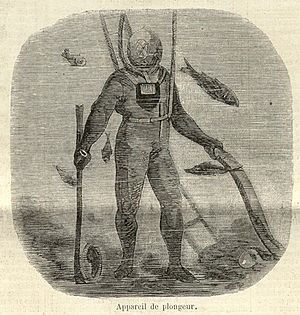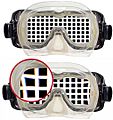Underwater diving facts for kids
Underwater diving is going underwater to do things. There are different reasons to do this:
- Recreational diving is done for fun. It is sometimes called sport diving. It can be done using air from cylinders carried by the diver. This is called scuba diving. It can also be done for shorter dives by holding your breath. This is called freediving or skindiving.
- Military diving is diving for a military purpose.
- Commercial diving is diving to do underwater work. This is done as part of a project where the work must be done under water.
- Scientific diving is diving done to find things out for scientific purposes. It may be part of the job for a scientist, or done by volunteer for a citizen science project.
- Public safety diving is diving done by a public service organisation like the police of a fire department to rescue people or to find and bring back bodies or evidence.
There are also different ways to dive:
- Surface supplied diving gets air for breathing through a hose from a pump above the surface of the water.
- Scuba diving is done with metal cylinders carried by the diver to hold the breathing air. In open-circuit scuba the air comes out of the mouthpiece when the diver breathes in, and goes into the water when the diver breathes out. When a rebreather is used, some of the same air is breathed many times, and the machine puts oxygen into the air to make up for the oxygen that is used up, and takes out the carbon dioxide by using a chemical to absorb it. A rebreather lets the diver use less air, but it can go wrong in more different ways.
- Saturation diving is diving where the divers stay in pressurised rooms between dives and go to the underwater workplace and return in a sealed diving bell, so they stay at the same pressure for days or weeks at a time before the pressure is reduced to normal air pressure when they finish the contract. The breathing gas is supplied from the surface through a hose so this is also a kind of surface supplied diving.
- Freediving is diving underwater without an air supply. The diver must hold their breath until they get back to the surface.
Images for kids
-
Commercial diver training in a quarry
See also
 In Spanish: Buceo para niños
In Spanish: Buceo para niños

All content from Kiddle encyclopedia articles (including the article images and facts) can be freely used under Attribution-ShareAlike license, unless stated otherwise. Cite this article:
Underwater diving Facts for Kids. Kiddle Encyclopedia.











